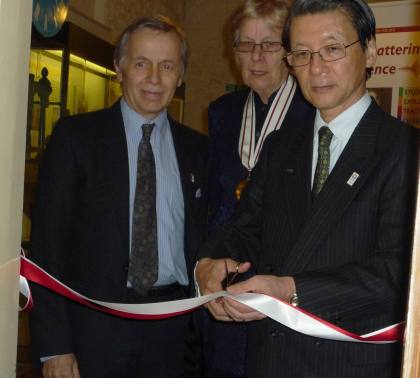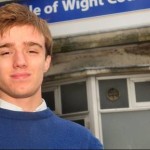
Many thanks to Suzanne and Alan for this report from yesterday’s visit by the Japanese Ambassador to Carisbrooke Castle. Ed
2013 marks the centenary of the death of John Milne, who pioneered modern seismology. As he lived on the Isle of Wight in his later years it is appropriate that Carisbrooke Castle Museum should mount an exhibition in his honour.
Much of Milne’s development of seismology took place in Japan, where he had been appointed to the post of Professor of Minerals and Geology in 1875. Following the 1880 Tokyo – Yokohama earthquake Milne’s interest in earthquakes became a passion. He was instrumental in founding the Seismology Movement in Japan.
In all, Milne spent twenty years studying seismology in Japan and became well revered. In 1895 the Emperor awarded him the Order of the Rising Sun. He was subsequently made Professor Emeritus of Tokyo University.
Ambassadorial visit to the castle
Considering the close links between Britain and Japan forged by the study of earthquakes it was appropriate that the Japanese Ambassador should officially open the John Milne exhibition on Monday 15th April, 2013.
His Excellency, Mr Keiichi Hayashi arrived at Carisbrooke Castle and was escorted by Judi Griffin, Chairman of the Carisbrooke Castle Museum Trustees. After signing the Visitors Book he was given a guided tour of the Museum.
Memento gifted to Ambassador
Judi Griffin gave the Ambassador a signed copy of Patrick Nott’s book detailing the life of John Milne as a memento. In welcoming His Excellency to the Castle Judi said the Museum cared for a large collection and they had enough items to mount an exhibition commemorating John Milne.
Mr. Hayashi said he was personally very happy to be given the opportunity to visit the island for the very first time. As a student in England in 1972 he had learnt about the IW Festivals of 1968, 1969 and 1970. On completing his speech he presented a gold screen to Judi Griffin as a token of friendship.
Life of John Milne
John Milne was born in Rochdale on 30th December 1850. As a student of geology he learnt about volcanoes and earthquakes. On a visit to Iceland in 1871 he studied volcanoes and geysers.
Following his appointment to work in Japan his journey from England took203 days via Russia. In Japan, Samurai rule had ended in 1868, with the restoration of the young Emperor Meigi.
Milne was to marry a Japanese girl in 1881. Tone Horikawa was the daughter of the Abbot of Hakodate’s Buddhist Temple. Milne designed a seismometer to investigate vibrations in buildings and bridges in 1889. By 1894 he had developed the Milne Horizontal Pendulum Seismograph.
A move to Newport
His purchase of Shide Hill House just outside of Newport was to see the second stage of his seismology studies, with Shide becoming the epicentre of such research.
Milne became deeply involved in social life on the Island including captaincy of Newport Golf Club. An annual competition for a trophy bearing his name is still contested.
Carisbrooke Castle Museum has a working seismograph , which in 2011 detected the Japanese earthquake/ tsunami, as well as a collection of 2,500 glass plate photos of Milne’s residency on the Island.
Images of Professor Milne and related photos can be viewed/purchased on line at www.historicimages.co.uk




